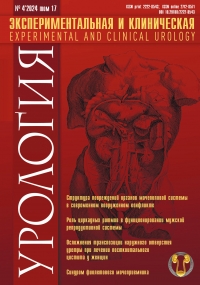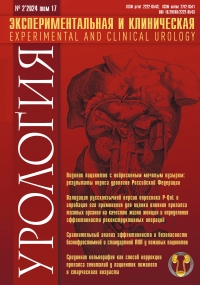Advantages and features of extraurethral prostatectomy compared to endourethral, transurethral and retropubic
 3681
3681 N.F. Sergienko, M.I. Vasil'chenko, O.I. Kudryashov, A.I. Begaev, A.V. Shchekochikhin, S.P. Shershnev, O.L. Reynyuk, M.M. Lotockiy
Objective – comparative study of benign prostatic hyperplasia surgical treatment results after extraurethral, endourethral, transurethral and retropubic approaches. 2029 patients were included into study, 1000 patients after transvesical extraurethral prostatectomy (EUA), 249 after standard endourethral prostatectomy, 750 after transurethral resection of prostate and 30 after retropubic modificated prostatectomy. There were no limitation for transvesical prostatectomy. Transurethral resection was performed in patients with mostly intravesical growth of hyperplasia with volume less than 60 ml, retropubic prostatectomy was performed in patients with any volume of hyperplasia with lateral localization in both lobes. Patients had 2nd and 3rd disease stage. Extraurethral and retropubic prostatectomies were performed with urethral catheter. In these patients prostatic urethra, urethral and dorsal venous complexes were preserved. The authors identified eight distinctive features extraurethral prostatectomy. EAU is an effective treatment for patients with benign prostatic hyperplasia, despite the incision of the soft tissues anterior abdominal wall. EAU is used for all forms of growth and varying volume of adenomatous tissues, including the presence of bladder diverticulum, tumors, stones, and abnormal location of ostium ureteris. EUA is performed in uretero- and pyeloectasia, renal failure, cardiopulmonary failure and other comorbidities. EAU does not cause such complication as "adenoms bed", urethral stricture, scar deformation of the bladder neck, urinary incontinence. EAU produces complication 5 time freqently then TUR of the prostate (5,6% vs 28,7%).


















































































